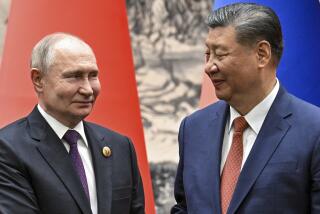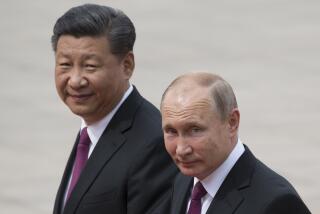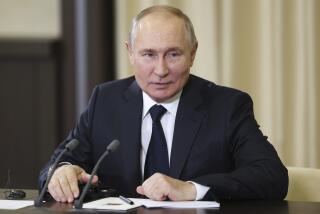‘Problems Similar,’ Gorbachev Tells Visitor From Beijing
MOSCOW — Following in Mao Tse-tung’s footsteps, Jiang Zemin on Wednesday began the first visit to the Soviet Union by a leader of China’s Communist Party in 34 years as the world’s two socialist giants, despite starkly differing paths of reform, intensified their search for a new relationship.
“Problems facing our countries are similar in many respects,” Soviet President Mikhail S. Gorbachev said at a Kremlin dinner in honor of his guest. “The ‘super task’ is also the same: to modernize society, its economy and the state in the interests of the workers and all people with due regard for world experience and without losing one’s supreme national values and cultural distinctiveness.”
The Chinese Communist Party general secretary’s five-day stay is the return trip for Gorbachev’s groundbreaking visit to Beijing two years earlier, which officially ended frosty relations dating back to the 1960s, when Moscow and Beijing, former allies, jockeyed for leadership of the world Communist movement.
Unlike Gorbachev’s headline-making 1989 trip, which came days before a crackdown on pro-democracy demonstrators in Beijing’s Tian An Men Square, Jiang’s stay is expected to be dominated by an earnest if mundane series of talks on how to improve ties even further. For Jiang, who also chairs China’s Central Military Council, the trip is a homecoming of sorts: In the mid-1950s, he worked as an engineering trainee at Moscow’s ZIL auto plant, which crafts limousines for the Kremlin elite.
“Relations between our countries are now at the point where the most complicated problems are no longer in concrete areas--like the borders--but in general approaches to issues,” observed Sergei N. Goncharov, chief of the Department of Soviet-Chinese Relations at the Soviet Far Eastern Institute.
Before leaving Beijing, Jiang said that he expected to sign a treaty in Moscow demarcating the segment of the Chinese-Soviet frontier running from Mongolia to North Korea. The two countries came to blows over the exact location of the border in the 1960s.
That treaty, however, seems to be mostly symbolic and does not resolve many contentious issues. According to Soviet Foreign Minister Alexander A. Bessmertnykh, only “90%” of the border has been defined to date, and the remainder reportedly includes the very islands in the Amur River where Soviet and Chinese soldiers once clashed.
On the eve of Jiang’s arrival, Soviet experts on China were also speaking of a rumored project to sell advanced Sukhoi-27 jet fighters to Beijing--a notion that alarms some U.S. allies in the region--as if it were already a done deal.
“Today we must earn foreign exchange,” Vladimir S. Myasnikov, a career Sinologist and deputy director of the Far Eastern Institute, said by way of explanation.
During his talks with Gorbachev and other Kremlin figures, Jiang is expected to sound out the Soviets on their commitment to the “socialist choice” and Gorbachev’s precise intentions for economic and political ties, and both men will look for ways to increase two-way trade.
Given the size of the economies involved, trade between China and the Soviet Union is quite small--about $3.9 billion this year, up 5% from 1989, by Chinese calculations.
“China has advantages in agriculture, the textile industry and labor resources, and the Soviet Union has a powerful heavy industrial foundation and rich natural resources,” the official Beijing Review noted Monday. “Therefore, cooperation between the two countries has a great potential.”
More to Read
Sign up for Essential California
The most important California stories and recommendations in your inbox every morning.
You may occasionally receive promotional content from the Los Angeles Times.










